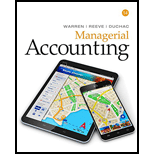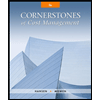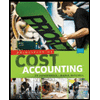
Concept explainers
A.
Single plant-wide factory overhead rate: The rate at which the factory or manufacturing
Formula to compute single plant-wide overhead rate:
Activity-based costing (ABC) method: The costing method which allocates overheads to the products based on factory overhead rate for each activity or cost object, according to the cost pooled for the cost drivers (allocation base).
Formula to compute activity-based overhead rate:
To compute: The single plant-wide overhead rate using direct machine hours (DLH) as the allocation base, and compute factory overhead or indirect labor cost allocated per unit
A.
Explanation of Solution
Compute single plant-wide overhead rate using DLH as the allocation base.
Compute the factory overhead allocated per unit for each product.
Step 1: Compute DLH per unit for cell phones.
Step 2: Compute DLH per unit for tablets.
Step 3: Compute indirect labor cost or factory overhead allocated per unit of each product.
| Types of Products | Single Plant-Wide Overhead Rate | × | Number of DLH Per Unit of Each Product | = | Factory Overhead Per Unit |
| Cell phones | $100 per DLH | × | 0.2 DLH | = | $2 per unit |
| Tablets | $100 per DLH | × | 0.2 DLH | = | $2 per unit |
Table (1)
Note: Refer to Equation (1) for value and computation of single plant-wide overhead rate. Refer to Equations (2) and (3) for value and computation of DLH per unit of each product.
B.
To compute: The activity-based overhead rate for each of the given activities
B.
Explanation of Solution
Compute activity-based overhead rates for each activity.
Step 1: Compute activity cost for setup activity.
Step 2: Compute activity cost for production support activity.
Step 3: Compute activity-based overhead rates for each activity.
| Computation of Activity-Based Overhead Rates | |||||
| Activity | Activity Cost | ÷ | Total Activity-Base Usage | = | Activity-Based Overhead Rates |
| Setup | $150,000 | ÷ | 2,000 setups | = | $75 per setup |
| Production support | 225,000 | ÷ | 3,750 DLH | = | $60 per DLH |
Table (2)
Note: Refer to Equations (4) and (5) for value and computation of activity cost.
C.
To compute: The activity-cost per unit of the products
C.
Explanation of Solution
Compute activity cost allocated per unit of cell phone.
| Activity | Activity-Based Overhead Rates | × | Actual Use of Activity-Base (Cost Driver) | = | Activity Cost Allocated |
| Setup | $75 per setup | × | 600 setups | = | $45,000 |
| Production support | $60 per DLH | × | 1,875 DLH | = | 112,500 |
| Total activity costs allocated to cell phones | $157,500 | ||||
| Number of units of cell phone | ÷ 93,750 units | ||||
| Activity-based overhead cost per unit of cell phone | $1,68 | ||||
Table (3)
Note: Refer to Table (2) for the value and computation of activity allocation rates.
Compute activity cost allocated per unit of tablet.
| Activity | Activity-Based Overhead Rates | × | Actual Use of Activity-Base (Cost Driver) | = | Activity Cost Allocated |
| Setup | $75 per setup | × | 1,400 setups | = | $105,000 |
| Production support | $60 per DLH | × | 1,875 DLH | = | 112,500 |
| Total activity costs allocated to tablets | $217,500 | ||||
| Number of units of tablet | ÷ 93,750 units | ||||
| Activity-based overhead cost per unit of tablet | $2.32 | ||||
Table (3)
Note: Refer to Table (2) for the value and computation of activity allocation rates.
D.
To discuss: The product cost distortion due to single plant-wide overhead rate
D.
Explanation of Solution
The product cost under single plant-wide overhead rate approach and ABC approach are different. The product cost is distorted in single plant-wide overhead rate approach because the time spent for setup production for cell phones and tablets is not in the same ratio as the direct labor hours used in support production for cell phones and tablets.
Want to see more full solutions like this?
Chapter 4 Solutions
Managerial Accounting
- solve step by step : A company purchased equipment for $50,000. It expects the equipment to have a useful life of 5 years and no salvage value. Using the straight-line method of depreciation, what is the annual depreciation expense?arrow_forwardI need help with this general accounting question using the proper accounting approach.arrow_forwardA company has the following information for the year:Net Income: $200,000Dividends Paid: $50,000Beginning Retained Earnings: $100,000What is the ending retained earnings?arrow_forward
- I am searching for the correct answer to this general accounting problem with proper accounting rules.arrow_forwardFrom this information, it appears that the company is using a predetermined overhead rate, as a percentage of direct labor costs, ofarrow_forwardI want answer with all working formatarrow_forward
- A company purchased equipment for $50,000. It expects the equipment to have a useful life of 5 years and no salvage value. Using the straight-line method of depreciation, what is the annual depreciation expense?arrow_forwardOverhead costs were applied at a single, plantwide overhead rate of 250 percent of direct labor dollars.arrow_forwardDon't use ai tool . A company has total liabilities of $400,000 and equity of $600,000. What is the company's debt-to-equity ratio?arrow_forward
 Managerial AccountingAccountingISBN:9781337912020Author:Carl Warren, Ph.d. Cma William B. TaylerPublisher:South-Western College Pub
Managerial AccountingAccountingISBN:9781337912020Author:Carl Warren, Ph.d. Cma William B. TaylerPublisher:South-Western College Pub Financial And Managerial AccountingAccountingISBN:9781337902663Author:WARREN, Carl S.Publisher:Cengage Learning,
Financial And Managerial AccountingAccountingISBN:9781337902663Author:WARREN, Carl S.Publisher:Cengage Learning, Cornerstones of Cost Management (Cornerstones Ser...AccountingISBN:9781305970663Author:Don R. Hansen, Maryanne M. MowenPublisher:Cengage Learning
Cornerstones of Cost Management (Cornerstones Ser...AccountingISBN:9781305970663Author:Don R. Hansen, Maryanne M. MowenPublisher:Cengage Learning Excel Applications for Accounting PrinciplesAccountingISBN:9781111581565Author:Gaylord N. SmithPublisher:Cengage LearningPrinciples of Accounting Volume 2AccountingISBN:9781947172609Author:OpenStaxPublisher:OpenStax College
Excel Applications for Accounting PrinciplesAccountingISBN:9781111581565Author:Gaylord N. SmithPublisher:Cengage LearningPrinciples of Accounting Volume 2AccountingISBN:9781947172609Author:OpenStaxPublisher:OpenStax College Principles of Cost AccountingAccountingISBN:9781305087408Author:Edward J. Vanderbeck, Maria R. MitchellPublisher:Cengage Learning
Principles of Cost AccountingAccountingISBN:9781305087408Author:Edward J. Vanderbeck, Maria R. MitchellPublisher:Cengage Learning





